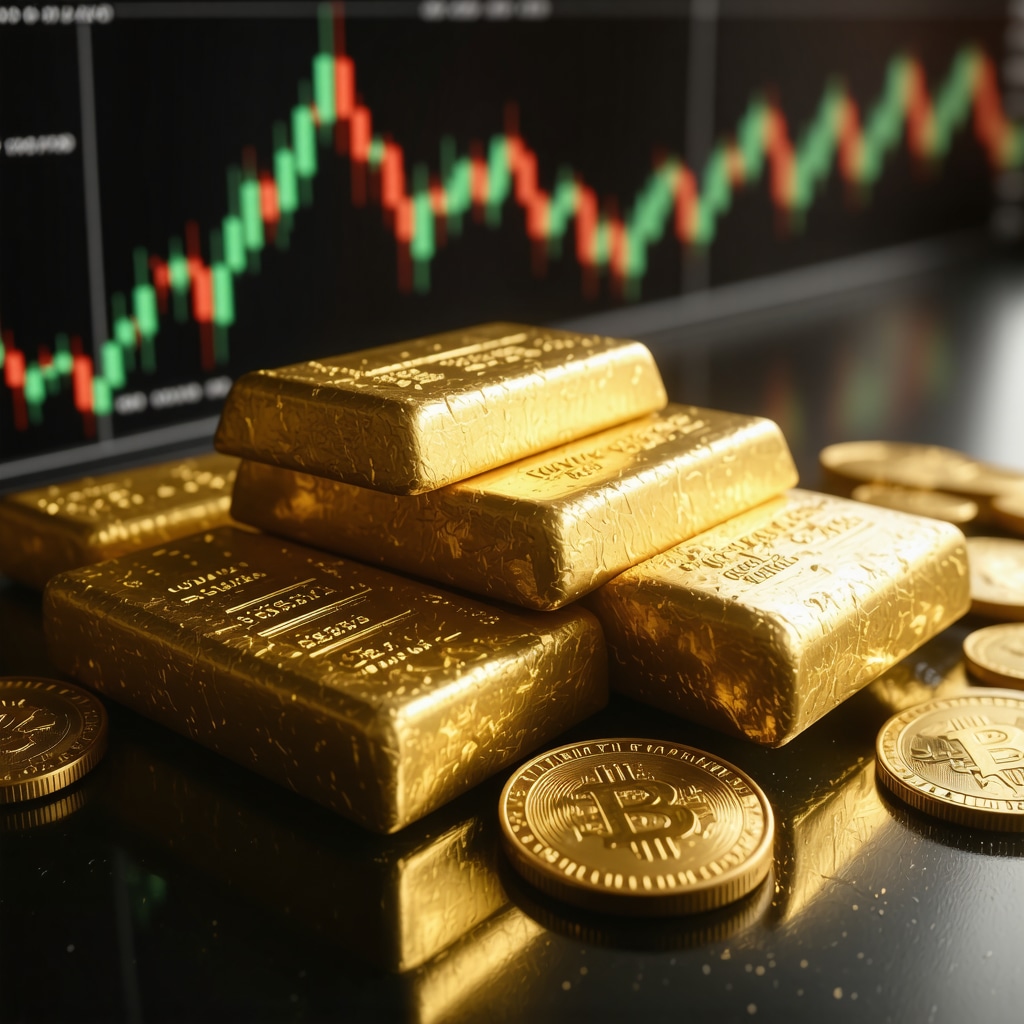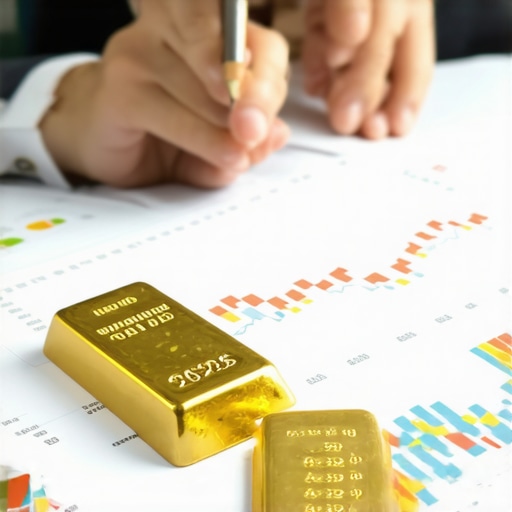Decoding the Rise and Fall: What Drives Gold Demand?
Gold remains one of the most captivating assets for investors around the globe, thanks to its intrinsic value and historical role as a store of wealth. However, the dynamics behind gold demand have evolved significantly in recent years, influenced by an intricate interplay of economic, geopolitical, and technological factors. For investors aiming to anticipate market movements or allocate assets wisely, a nuanced understanding of these trends is indispensable.
Beyond the Glitter: Unpacking the Multifaceted Drivers of Gold Demand
Gold demand is not monolithic—it reflects diverse market segments including jewelry, technology, central bank reserves, and investment vehicles. Jewelry consumption, predominantly driven by cultural and economic factors in countries like India and China, continues to influence global demand. Meanwhile, technological applications, such as in electronics and medical devices, contribute steadily but less dramatically.
Central banks have increasingly become pivotal players, often adjusting their gold reserves as a hedge against currency volatility and geopolitical risk. Investment demand, fueled by ETFs, futures, and physical bullion purchases, tends to fluctuate with macroeconomic uncertainties and inflationary pressures. These layers of demand interweave to create a complex picture that savvy investors must decode.
How Do Shifts in Global Economics and Politics Impact Gold Demand?
Gold historically thrives during periods of economic instability and geopolitical tension. For instance, rising inflation rates often erode fiat currency value, nudging investors toward gold’s relative stability. Similarly, trade disputes or conflicts can trigger safe-haven buying. Recent trends show that as governments pursue unconventional monetary policies, gold demand surges as a protective asset.
This relationship is exemplified by the 2020 global health crisis, which saw unprecedented gold purchases amid market turmoil. Investors who understood these demand drivers capitalized on price appreciation as the metal’s appeal as a refuge intensified.
Reading the Signals: Using Gold Demand Trends to Predict Price Movements
For investors, deciphering gold demand trends is not just academic—it directly informs strategic decisions. Monitoring central bank activities, jewelry market shifts, and investment flows can provide early indicators of price trajectories. For example, a surge in gold-backed ETF inflows often signals growing investor confidence in gold as a hedge.
Integrating demand trend analysis with supply-side insights—such as mining output and recycling rates—offers a holistic view crucial for forecasting. As highlighted by the World Gold Council, comprehensive data on demand sources empowers investors to navigate volatility and identify opportune moments for entry or exit.
Strategic Adaptation: Aligning Your Portfolio with Emerging Gold Demand Patterns
Understanding evolving demand trends enables investors to tailor their gold exposure effectively. Whether diversifying through physical gold, ETFs, or mining stocks, aligning choices with market realities enhances resilience and return potential. For those curious about how to integrate gold into their investment strategy, resources like this detailed guide provide actionable insights.
Moreover, recognizing the cyclical nature of demand—such as seasonal jewelry buying spikes or shifts in central bank policies—can refine timing decisions.
Engage with the Gold Investment Community
Have you noticed shifts in gold demand that influenced your investment decisions? Share your experiences and insights in the comments below to foster a community of informed investors. For more expert strategies on gold investing, explore our comprehensive resources and stay ahead in the market.
Personal Reflections on Gold Demand and Market Timing
Reflecting on my own journey with gold investments, I’ve come to appreciate how timing and understanding demand nuances can be game-changers. Early in my portfolio-building days, I overlooked the subtle shifts in consumer jewelry buying seasons and central bank reserve announcements. It was only after several market cycles that I realized these signals often foreshadow price adjustments.
For example, during the past few years, observing how Chinese New Year celebrations and Indian festival seasons boosted jewelry demand helped me anticipate short-term price rallies. Simultaneously, tracking central bank gold purchases gave me confidence in the metal’s long-term stability. This blend of cultural awareness and macroeconomic monitoring became a cornerstone of my more refined investment strategy.
How Can Investors Balance Physical Gold and Digital Gold Assets?
One question I frequently get from fellow investors is about the balance between physical gold holdings and digital gold assets like ETFs. From my experience, both have distinct advantages and risks. Physical gold offers tangible security and is less vulnerable to counterparty risk, but it requires safe storage and insurance. Digital gold, such as ETFs, provides liquidity and ease of trading but depends on market infrastructure and trust in the issuer.
Based on insights from the World Gold Council, many seasoned investors are now adopting a hybrid approach. They hold a core of physical gold for long-term wealth preservation while actively trading ETFs to capitalize on market volatility. This strategy aligns well with my personal portfolio, where physical gold forms the bedrock and ETFs add agility.
Adapting to Emerging Gold Demand Trends in Technology and Sustainability
Beyond traditional demand drivers, I’ve noticed exciting shifts in gold’s role within technology and sustainability sectors. For instance, gold’s exceptional conductivity and corrosion resistance make it invaluable in electronics, from smartphones to advanced medical devices. This technological demand, while smaller than jewelry or investment, is steadily growing and contributes to a more diversified demand base.
Moreover, the push for sustainable mining and ethical sourcing has started influencing investor choices. I’ve personally started exploring gold mining stocks that emphasize environmental responsibility and social governance, which reflect a broader trend toward sustainable investing. This approach not only aligns with my values but also taps into a growing market segment that could offer competitive returns.
What Are Your Experiences With Gold Investment Strategies?
I’d love to hear from you. Have you found certain gold demand signals that helped you make smarter investment moves? Or perhaps you’ve explored combining physical gold with ETFs or mining stocks? Sharing your stories enriches our community and helps everyone grow smarter together. Feel free to drop a comment below or check out related guides like gold demand trends insights to deepen your knowledge.
Unmasking the Impact of Technological Innovations on Gold Demand Trajectories
Delving deeper into the technological sphere, gold’s role extends far beyond its historical and ornamental allure. Its unparalleled electrical conductivity, malleability, and resistance to oxidation have positioned it as an indispensable material in cutting-edge electronics, aerospace, and medical devices. As devices shrink in size while increasing in complexity, the demand for gold in microelectronics, including connectors and printed circuit boards, grows correspondingly.
However, this demand is not without its challenges. The rapid pace of technological innovation introduces volatility in consumption patterns, as alternative materials and recycling advancements potentially diminish raw gold requirements. For investors, understanding these nuanced shifts—such as how emerging flexible electronics or quantum computing might alter gold usage—is critical to anticipate medium- to long-term demand fluctuations.
Ethical Gold Mining: The Rising Influence of ESG Criteria on Investment Decisions
Environmental, Social, and Governance (ESG) considerations have revolutionized how investors evaluate gold mining companies. Increasingly, stakeholders demand transparency on mining practices, community impact, and environmental stewardship. Companies that embrace sustainable mining protocols—such as reduced water usage, land reclamation, and fair labor policies—are not only mitigating operational risks but also enhancing their appeal to conscientious investors.
This paradigm shift implicates gold demand in a broader socio-economic context. Mining firms with robust ESG frameworks often experience better access to capital and enjoy premium valuations, underscoring the intersection between ethical considerations and market performance. For portfolio strategists, integrating ESG metrics into gold-related investments is becoming paramount to align financial returns with responsible stewardship.
How Does the Rising Popularity of Digital Gold Platforms Affect Physical Gold Holdings?
The proliferation of digital gold platforms—offering fractional ownership, instant liquidity, and streamlined access—has transformed the landscape for gold investors. While these platforms democratize gold investment by lowering entry barriers, they introduce questions about ownership security, regulatory oversight, and counterparty risks.
From an advanced investor’s perspective, balancing digital gold exposure with physical holdings is a sophisticated exercise in risk management. Digital assets facilitate tactical trading and portfolio agility but may lack the tangible security of physical bullion, especially during extreme market stress. Consequently, a hybrid allocation strategy, calibrated to individual risk tolerance and market environment, often emerges as the optimal approach.
As noted by the World Gold Council’s detailed supply-demand reports, understanding the interplay between these modalities informs smarter allocation and hedging strategies.
Harnessing Data Analytics and AI to Decode Gold Demand Patterns
In the era of big data, leveraging advanced analytics and artificial intelligence (AI) tools has become a frontier for predicting gold demand with unprecedented precision. Machine learning algorithms can ingest vast datasets—from geopolitical news feeds and currency fluctuations to consumer behavior and mining outputs—to identify subtle correlations and emergent trends.
For instance, sentiment analysis of social media and financial news can provide early warnings of market anxiety, often precursors to spikes in gold investment demand. Similarly, predictive models that incorporate macroeconomic indicators enable more responsive and dynamic portfolio adjustments.
Investors equipped with these technologies gain a competitive advantage, transforming reactive strategies into proactive, data-driven decision-making processes.
Engage Further: How Are You Integrating Emerging Gold Demand Insights into Your Investment Blueprint?
The evolving landscape of gold demand offers a wealth of opportunities for those willing to delve beyond surface-level trends. Have you explored integrating ESG evaluations or AI-based analytics into your gold investment framework? Share your experiences and insights in the comments below to contribute to a collective intelligence that empowers all investors.
Integrating Macro-Financial Indicators for Sophisticated Gold Demand Forecasting
Seasoned investors increasingly recognize that gold demand is intricately tied to an array of macro-financial indicators beyond traditional metrics. Variables such as real interest rates, currency strength, and sovereign debt levels can profoundly influence investor appetite for gold. For example, declining real yields often incentivize allocation to gold, which offers no yield but provides inflation hedging and portfolio diversification.
Moreover, global liquidity conditions driven by central bank policies shape speculative demand and impact physical acquisition patterns. Proactive monitoring of these financial variables empowers investors to anticipate demand shifts ahead of price movements, allowing for tactical positioning that captures asymmetric risk-reward opportunities.
Unveiling the Impact of Central Bank Digital Currencies (CBDCs) on Gold Investment Paradigms
The emergence of Central Bank Digital Currencies (CBDCs) introduces a novel variable into the gold demand equation. As nations explore digital fiat currencies, the traditional role of gold as a monetary reserve asset may undergo transformation. CBDCs could streamline cross-border settlements and reduce reliance on physical reserves, potentially diminishing the conventional central bank demand for gold.
However, CBDCs also carry inflationary and geopolitical uncertainties that might paradoxically augment gold’s safe-haven appeal among private investors. Advanced investors should thus analyze CBDC developments within a nuanced framework that balances disruptive innovation with enduring fundamentals underpinning gold’s monetary significance.
How Can Quantitative Models Incorporate ESG Metrics to Refine Gold Mining Investment Decisions?
Incorporating Environmental, Social, and Governance (ESG) criteria into quantitative investment models for gold mining stocks is an emerging frontier. By integrating ESG scores with traditional financial indicators such as price-to-earnings ratios, cash flow stability, and geopolitical risk assessments, investors can construct multifactor models that identify mining companies with sustainable competitive advantages.
Such models exploit the positive correlation between robust ESG practices and operational resilience, regulatory compliance, and enhanced stakeholder trust. Consequently, portfolios optimized with ESG integration may not only mitigate reputational risks but also capture alpha from evolving investor preferences favoring sustainable enterprises.
For a comprehensive framework on ESG integration in gold investments, refer to the MSCI report on ESG Integration in Commodities, which offers rigorous methodologies and case studies.
Leveraging Blockchain Transparency to Enhance Gold Supply Chain Integrity
Blockchain technology offers transformative potential to revolutionize traceability and trust within the gold supply chain. By recording gold provenance and transaction history on immutable ledgers, stakeholders can verify ethical sourcing, reduce fraud, and improve regulatory compliance.
This transparency bolsters investor confidence, particularly for those prioritizing socially responsible investment mandates. Furthermore, blockchain-enabled smart contracts can facilitate automated compliance and streamline ownership transfers, enhancing liquidity in secondary markets. Investors attuned to these technological advancements can exploit early adoption benefits within ancillary gold-related assets and instruments.

Elevating Portfolio Resilience: Tactical Responses to Volatile Gold Demand Signals
Rapid shifts in gold demand often necessitate agile portfolio adjustments. Employing tactical asset allocation strategies that incorporate real-time demand analytics—such as ETF flow data, retail buying trends, and central bank announcements—can optimize entry and exit timing. Dynamic rebalancing informed by machine learning forecasts further refines risk management by anticipating volatility spikes and demand contractions.
Such sophisticated approaches contrast with static allocation models, offering enhanced downside protection and superior capture of upside momentum. Investors who master these techniques position themselves to harness gold’s cyclical and secular demand drivers more effectively.
Engage with Cutting-Edge Gold Investment Insights
Are you integrating advanced macro-financial analyses, ESG considerations, or blockchain innovations into your gold investment strategy? Share your methodologies and challenges in the comments to enrich this expert discourse. For further exploration of these sophisticated themes, subscribe to our newsletter and access exclusive research reports designed to elevate your investment acumen.
Frequently Asked Questions (FAQ)
What are the primary factors driving fluctuations in global gold demand?
The main drivers include jewelry consumption influenced by cultural and economic factors, investment demand linked to macroeconomic uncertainty and inflation, central bank reserve adjustments as hedges against currency volatility, and technological applications in electronics and medical devices. Geopolitical tensions and unconventional monetary policies also significantly impact demand.
How do central bank policies and digital currencies affect gold demand?
Central banks often adjust gold reserves to hedge against currency risks and geopolitical uncertainty, increasing demand during volatile periods. The rise of Central Bank Digital Currencies (CBDCs) could streamline monetary systems and potentially reduce physical gold reserves held by governments, but may also heighten private investor demand for gold as a safe haven amid new financial uncertainties.
What is the role of ESG (Environmental, Social, and Governance) criteria in gold investment?
ESG considerations are increasingly vital in evaluating gold mining companies, affecting investor decisions and company valuations. Firms with strong ESG practices often enjoy better access to capital and operational resilience, making ESG integration crucial for sustainable and responsible gold mining investments.
How can investors balance physical gold and digital gold assets effectively?
Physical gold offers tangible security but requires storage and insurance, while digital gold assets like ETFs provide liquidity and ease of trading but entail counterparty risks. Many investors adopt a hybrid strategy, maintaining physical gold for long-term preservation and using digital assets for portfolio agility and tactical trading.
In what ways is technology influencing gold demand trends?
Gold’s exceptional properties make it indispensable in advanced electronics, aerospace, and medical devices, driving steady technological demand. However, innovation and recycling advancements can introduce volatility by reducing raw gold needs. Understanding these dynamics helps investors anticipate medium- to long-term shifts in demand.
How do macro-financial indicators integrate with gold demand forecasting?
Indicators like real interest rates, currency strength, sovereign debt levels, and global liquidity conditions shape investor appetite for gold. Declining real yields tend to increase gold demand as investors seek inflation hedges and diversification, making these variables key inputs for sophisticated forecasting models.
What advantages does blockchain technology offer for gold supply chain transparency?
Blockchain enables immutable records of gold provenance and transaction history, enhancing ethical sourcing verification, reducing fraud, and improving regulatory compliance. This transparency increases investor confidence, particularly among those focused on socially responsible investing, while facilitating liquidity through smart contracts.
How can AI and data analytics improve gold demand prediction?
AI and machine learning analyze vast datasets including geopolitical news, financial indicators, and consumer behavior to detect subtle patterns and emerging trends. Sentiment analysis and predictive modeling empower investors to make proactive, data-driven decisions, improving timing and risk management in gold investments.
What tactical approaches can investors use to respond to volatile gold demand signals?
Employing dynamic asset allocation strategies informed by real-time demand analytics, ETF flows, and central bank activity allows investors to optimize entry and exit timing. Machine learning forecasts help anticipate volatility, enabling agile portfolio rebalancing and enhanced risk-adjusted returns compared to static models.
How do ESG metrics integrate into quantitative models for gold mining investments?
By combining ESG scores with financial indicators such as earnings and cash flow stability, multifactor models identify mining companies with sustainable competitive advantages. This approach mitigates reputational and operational risks and aligns portfolios with evolving investor preferences for responsible enterprises.
Trusted External Sources
- World Gold Council: Provides comprehensive research and data on gold demand trends, supply dynamics, and investment insights, serving as a foundational resource for understanding gold markets globally.
- MSCI ESG Research: Offers rigorous methodologies and case studies on integrating ESG factors into commodity investments, including gold mining, helping investors align sustainability with financial performance.
- International Monetary Fund (IMF): Publishes analyses on global macro-financial indicators and the evolving role of gold in monetary reserves, especially relevant for understanding central bank behaviors and CBDC impacts.
- Cambridge Centre for Alternative Finance: Researches blockchain applications and digital asset trends, providing valuable insights into how technologies enhance gold supply chain transparency and investor confidence.
- Journal of Commodity Markets (Elsevier): Offers academic and empirical research on commodity price forecasting, including advanced quantitative models that incorporate macroeconomic and ESG variables for gold market analysis.
Conclusion
Gold demand remains a multifaceted and evolving phenomenon shaped by cultural traditions, technological innovation, geopolitical shifts, and financial market dynamics. Advanced investors who integrate insights from central bank policies, ESG criteria, emerging technologies, and macro-financial indicators position themselves to anticipate demand fluctuations and optimize portfolio strategies effectively.
By balancing physical holdings with digital assets, leveraging AI-driven analytics, and embracing transparency tools like blockchain, market participants can enhance resilience amid volatility. Furthermore, ethical considerations and sustainability are no longer peripheral but central to discerning gold investment decisions.
Ultimately, mastering these complex demand drivers empowers investors to harness gold’s enduring allure as both a store of value and a dynamic asset class. We encourage you to share your experiences, explore related expert resources, and apply these insights to refine your gold investment approach for sustained success.










